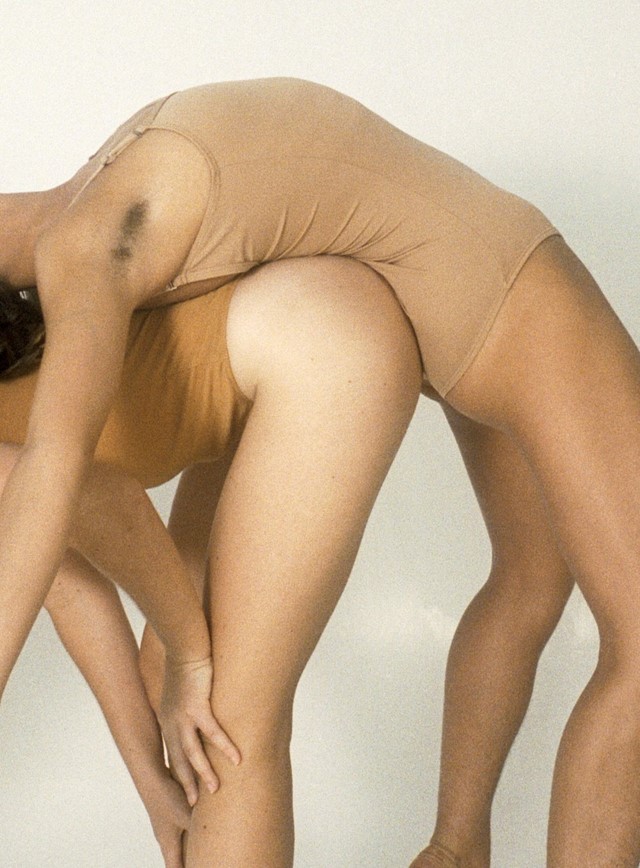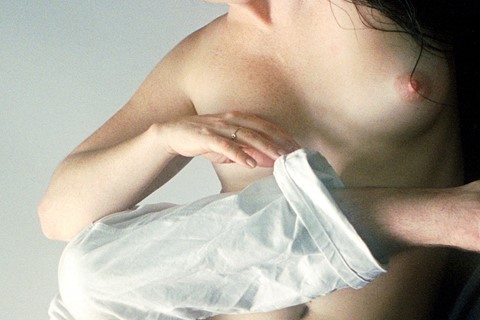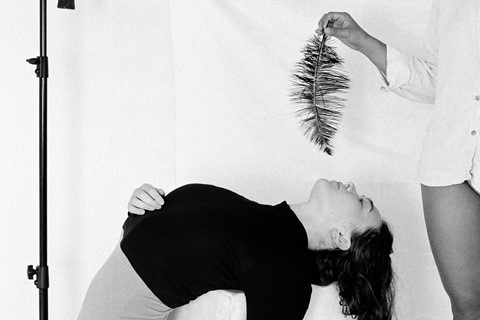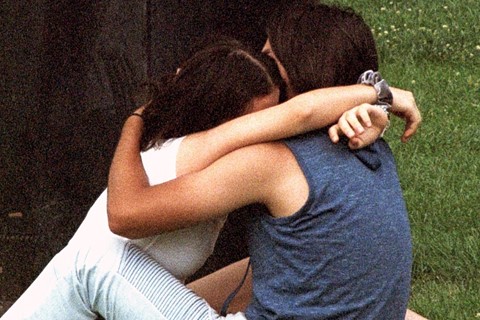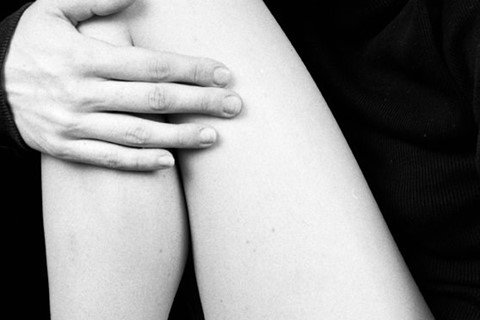In her studio photographs, New York-based photographer Jenna Westra gives her all-women models a set of instructions. Her current exhibition at Lubov – and its accompanying book – documents these moments as well as what slips through
Afternoons is a fitting title for New York-based artist Jenna Westra’s current exhibition at Chinatown gallery, Lubov – and a coinciding book, published by Hassla. The exhibition’s seven photographs delicately articulate that sense of a midday lull, with a handful of models collectedly moving their bodies based on Westra’s instructions. Supervision, however, subtly prevails the moments’ otherwise poetic contortions. The figures are equally determined and elusive, engaging with one another in vaguely narrated juxtapositions with cues from Modernist dance. In Dancers (Backbend) (2020), a woman in a tan-coloured leotard leans backwards onto the other’s back, caught between repose and discomfort. Feather Scene (2020) shows a model also stretching backwards for an encounter with a feather held by another woman – a third subject witnesses the scene on the right bottom and completes a tableau reminiscent of a pietà.
Westra captures the bodies with ease, leaving room for cracks slipping through her instructions and blurring the line between chance and decision. Tension is handled with care and poise, such as Untitled (2017) in which a model’s neck rests on the other’s hand when both parties are self-assured. Tights Pinch (2015) freezes a moment of tangible pressure between a woman’s hand and her pulled sheer tights. Park Picture (Les Fleurs) (2020) is unique for being the exhibition’s only outdoor shot and including its sole male subject. A couple is entangled, their torsos pressed together. They seem to hide away from something or someone, covering their faces with one another both for protection and out of yearning. They’re not subject to Westra’s instructions, but the artist’s lens observes them from afar, freezing the otherwise fleeting moment.
AnOther talked to Westra about her interest in leaving movements to chance as much as choreographing them and how the quarantine era brought her back outside of her studio.
“I don’t shoot too often, maybe once every couple of months, but in between shoots I think of ways I want to see bodies touch or interact - vignettes that hold some sort of tension. The instructions I present to the models can be really simple, such as a foot touching an arm, or a fruit prop held in an unexpected way, or a body leaning backwards onto another. I am also keenly aware that what is left out of the frame is just as important as what’s actually pictured, and use close cropping as a strategy to highlight this.
“I’m also open to letting things happen organically, which is even more of a possibility when working with dancers, or people who have an especially close connection with their physicality. In the current show, Dancers (Backbend) 2020 came from a moment where the models were trying things and moving around without any direction. I’ve come to appreciate and even try to pull out more of these chance moments, particularly in this show. The works in my last show with Lubov in 2018 all came from one five-hour shoot. I wanted to see what would happen if I gave myself a time and space limitation. In the current show, I have a couple of these very constructed studio images but also a picture taken in a public park as well as one work from 2015 and one from 2017. I’m becoming more interested in flattening a perceived hierarchy of image making techniques across time, and how this approach can be part of a larger conversation about the relationship between vernacular and constructed images, and the mechanics of photography itself.
“I have always used my studio as a set, which is quite small and has a darkroom in the basement. Recently, it hasn’t felt safe inviting people there, so I rented a professional studio for the first time but also went outside to shoot for the first time in years. I shot the couple embracing at Hunter’s Point Park in Long Island City. This is not the first time I’ve photographed a man – I have and I will again, but I choose men who have maybe a sort of sensitivity. In that moment, I was interested in tenderness and touch, something that touches and stays with you. This image is the start of a continuing investigation I plan to pursue, of finding images along with constructing them, again thinking of the perceived hierarchy there.
“Modernist aesthetic has been an important part of my development as a photographer. I have always been drawn to performance film stills of modern and post-modern choreographers, specifically of Pina Bausch and Yvonne Rainer. They prompt ideas about the way a camera can change a performance. When a camera is present instead of an audience, the way dancers orient themselves changes. I’m attracted to the body, space and performance of a specific moment, which is generally captured in Modern dance as well as films by 1970s feminist artists.”
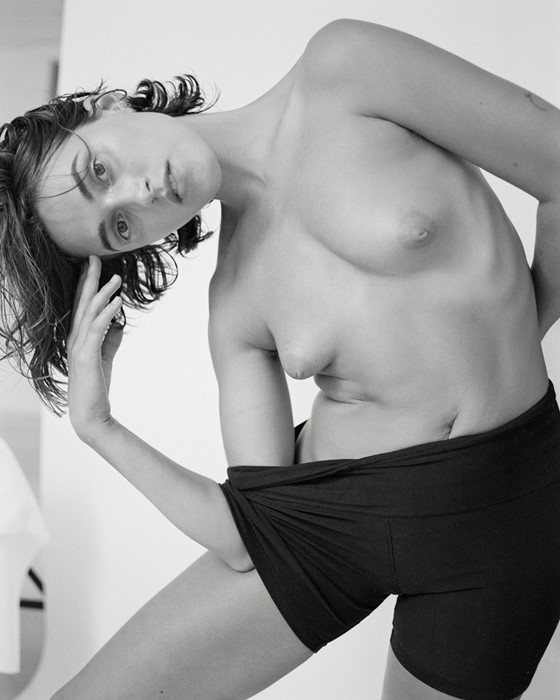
“I question if there is a different value in a found image as opposed to one that is constructed. I studied painting, so I initially figured out my relationship to photography through walking around with my camera. During the pandemic, I had the chance to go through old negatives from that period and decided to revisit that experience with a long lens. I recently read something Lisette Model said about the attraction of the snapshot. She talks about how it’s refreshing to see something which is done directly, without any intention of it being good or bad. I took it as permission to just do what I want, and it was such a freeing idea. I realised the couple’s image from the park fit within the show because I’m also including older works, and shuffling relationships between images and how they are made, either outdoors or in the studio, either directed or by chance between moments.
“There is a trust between myself and the models, who are not always dancers, to represent their bodies in a non-violent way, and by that I mean a way that doesn’t reinforce certain patriarchal ideals of the female form. I presented a film which showed some of my process in a 2018 exhibition from an urge to keep track of missed moments while bodies converge and interact in ways that I did not instruct them. Chance is also in the park scene, but in another mode of encounter between me and strangers in the distance.
“I would argue that chance is always present in photography, because you can never fully know what the camera is going to see or how things are going to look in the final image. Still, I am deeply interested in how the camera has the ability to capture and make slippery moments permanent. Social distancing has made me less specific with my instructions and open to negotiating. I trust my instincts better. Arm in Shorts (2020) was one of the last images we made at the end of a shoot. The model just made that gesture and it worked.”
Jenna Westra: Afternoons is at Lubov, 5 East Broadway, #402, New York City until November 22, 2020. The accompanying book is published by Hassla, pre-order a copy here.
